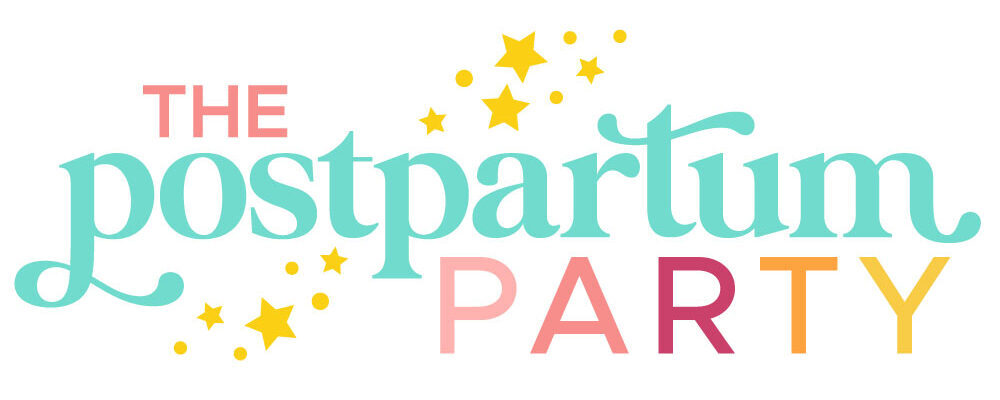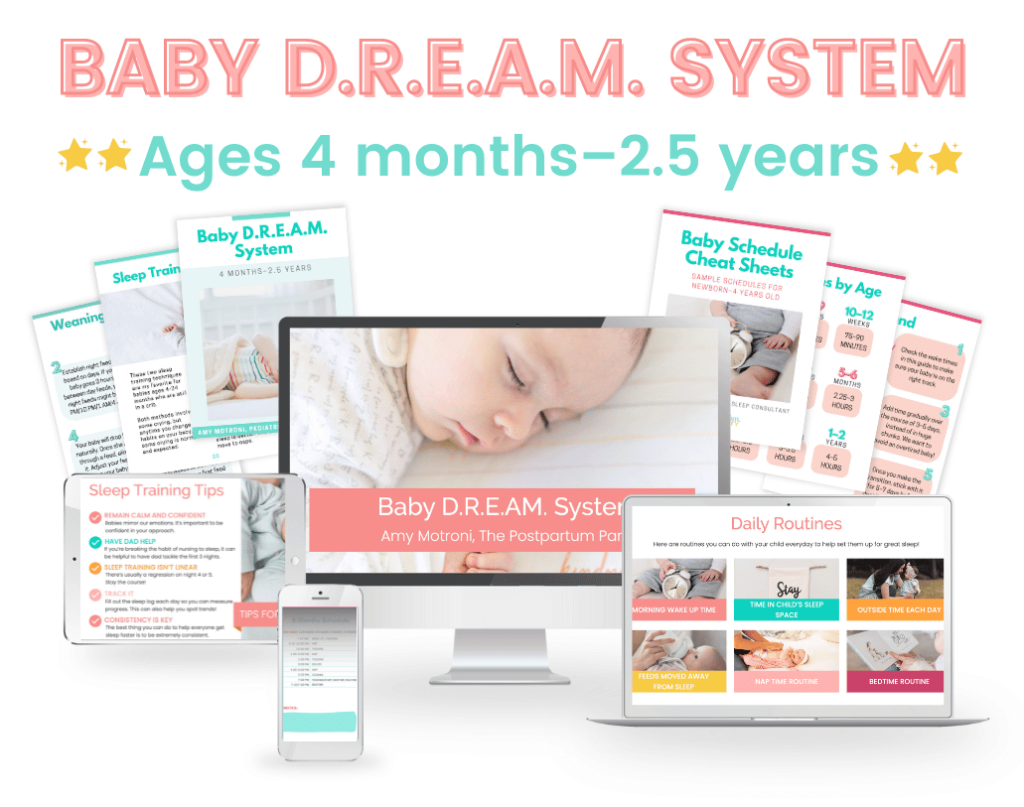Do you think your baby is ready to drop their night feedings? Are you ready to stop comfort feeding at night? Learn how you can wean night feedings for bottle fed and breastfed babies so everyone can sleep better at night.

Nighttime feedings have to be one of the most exhausting parts of being a parent.
Some parents may think those night feedings are so precious and sweet—those tender moments in the night when the rest of the house is quiet and still and it’s just you and baby in your arms.
It is one of the most endearing parts of motherhood and I know so many parents who cherish that time.
But for parents who are up 3, 4, or more times feeding their baby in the middle of the night, those tender night feeds quickly turn into exhaustion and desperation for them to end.
Some babies will automatically drop night feedings on their own, while others may need a little help. Whether your baby takes breast milk or formula, here’s how you can gently wean overnight feeds so everyone can get better sleep.
Is your baby struggling with short naps? To help you better, grab my free guide to solving short naps to get practical tips of how to get your baby to take longer naps every single day. Click here to grab it, it’ll be super helpful.

What is Night Weaning?
Night weaning is the process of your baby no longer taking feeds during the night. A feed is considered a night feed when it happens after you put your baby down for bed initially—usually between 7 and 8 p.m.
When Should Night Feedings Stop?
Social media posts from moms whose babies start sleeping through the night at 2 or 3 months old may make you feel like something is wrong if your baby is older and still needing feeds in the middle of the night.
The good news is that there’s no magic age when feedings should stop. As a general guide, most babies are not ready to drop all night feeds before they are 4 months of age and/or 12 pounds.
Still, many babies are not ready to eliminate all overnight feedings before 6 months of age. And some babies are not ready until closer to a year old.
Check with your pediatrician to help you determine when your baby no longer needs to eat at night from a nutritional or weight gain standpoint.
Do Babies Naturally Wean off Night Feeds?
Some babies will naturally wean off night feedings without any help. This is most likely to happen for babies who have independent sleep skills and don’t rely on a nursing session or a bottle to fall asleep at bedtime.
You may notice that over time, your baby starts sleeping longer stretches between feeds and eventually drops most, or even all, of them on their own.
However, for babies who are fed to sleep each time, they may not naturally wean those night feeds and need the breast or bottle to help them sleep each time.
When Should I Stop Night Feedings?
Most babies are not ready to wean from night feeds until they are at least four months old or twelve pounds.
If your baby is at least 4 months old or 12 pounds, then he might be ready to wean some of his night time feedings, but not all of them. Some babies still need one or two night feedings, especially up until 6 months old.
Check with your baby’s pediatrician to see if you can start to wean your baby from some or all of his night feedings. Once you get the okay from the doctor, you can use this blog post as a guide.
How to Get Baby to Eat More During the Day Instead of At Night
Often, when you start to wean night feeds, your baby will automatically move those calories to the daytime. As you start the weaning process, your baby will naturally increase the amount they eat at each feed or need an extra feeding during the day.
One way to wean night feedings that usually works well is to drop 1 ounce at a time for formula-fed babies or 2 minutes at a time from nursing.
That way your baby’s hunger at night will be satisfied while also helping them to start moving those calories to the daytime.
Keep on reading to see how you can gradually shift those calories from the middle of the night to their daytime feedings.
How Do I Stop Night Feedings?
There’s a lot that goes into getting your little one to sleep all night long without any feeds.
Sleep is a holistic approach, so before we tackle how to drop night feeds, make sure you have all the other elements in place that lead to good sleep.
1. Have a Consistent Bedtime Routine
The first step in weaning night feeds is making sure your baby’s bedtime routine is rock solid.
Follow the same 3 to 5 activities each night to help cue to your baby’s brain that sleep is coming.
Then, make sure to put your baby down awake.
A common misconception is to put your baby down drowsy but awake, but that can backfire as baby passes the 4-month mark.
2. Create a Good Sleep Environment
Your baby might not be waking up from hunger, It could be out of habit, or because their sleep space isn’t optimized.
Use blackout curtains and white noise to make your baby’s space conducive for space.
3. Use the Right Wake Windows for Baby
Set your baby up for success by making sure they aren’t overtired or under tired. Babies can wake up in the middle of the night from not having a good sleep schedule during the day, so make sure to optimize their day sleep for better night sleep.
4. Teach Baby How to Sleep On their Own
If your baby has the right sleep associations and can fall asleep at bedtime without assistance, then they’ll be more likely to be able to fall back asleep in the middle of the night when they wake up.
Does your baby wake up to feed because he is hungry, or does he need the feeding to go back to sleep, because that is what he is used to doing?
If your baby doesn’t have sleep associations and is ready to wean from night feedings, then here is how you can do it.
Please note that your milk supply may take a minute to catch up. Talk to a lactation consultant if you have any questions about your supply and weaning feeds.
Night Weaning for Breastfed Babies (Step-by-Step)
This is a gentle process that helps you slowly drop the nighttime feeds that are not sleep-prop related. This gives you a plan and confidence so you don’t just leave your baby to cry it out for night feedings.
Start with the Middle Feeding
First, start with the middle feeding in the middle of the night.
For example, if your baby has a feeding at 10 p.m., 1 a.m., and 4 a.m., start with the 1 a.m. feeding.
For that middle feeding (1 a.m. in our case), you will slowly reduce the time you spend nursing if he is a breastfed baby.
Gradually Reduce the Amount of Milk
If breastfed, reduce the amount of time spent feeding by two minutes each night.
Your baby will start to increase his milk intake / solid foods during the day to make up for those lost calories in that middle of the night feeding.
Repeat for Several Nights
Do this every night until that middle feeding is eliminated. Once that feeding is eliminated, you will start to reduce the number of ounces of the first night time feed.
Once you start this process, babies will start to use their soothing skills and may eliminate the other feedings on his own.
Night Weaning for Bottle-Fed Babies
Start with the Middle Feeding
You’ll follow the same process as above, starting with the middle feeding in the middle of the night.
For example, if your baby has a feeding at 10 p.m., 1 a.m., and 4 a.m., start with the 1 a.m. feeding.
For that middle feeding (1 a.m. in our case), you will slowly reduce the number of ounces that you include in his bottle.
Gradually Reduce the Amount of Milk
Reduce the amount of breastmilk or formula by 1/2 an ounce every night.
Your baby will start to increase his milk intake / solid foods during the day to make up for those lost calories in that middle of the night feeding.
Repeat for Several Nights
Do this every night until that middle feeding is eliminated. Once that feeding is eliminated, you will start to reduce the ounces of the first night time feed.
Get Better Sleep with The Baby D.R.E.A.M. System
If you want someone to walk you through the process of sleep training, let me help. The Baby D.R.E.A.M. System is for babies 4 months through 2.5 years old. I’ll walk you through how to establish daily routines, sleep schedules, and sleep training techniques to help you break the sleep associations you no longer find beneficial! Check it out here.
Which Night Feed to Drop First?
You’ll want to drop your baby’s middle of the night feeding first. Usually, this is going to be the feeding closest to midnight.
Once that feeding is gone, you can move to the feeding between bedtime and midnight. If your baby has an early morning feeding around 4:00 a.m. or 5:00 a.m., that will be the last feeding to go.
How Do I Stop Comfort Nursing at Night?
If your baby has developed a sleep association with nursing, then you will need to work to break the habit in order to night wean.
Babies’ sleep cycles last approximately 45 to 60 minutes and they are constantly waking up and then putting themselves back to sleep (we adults do this as well!). When a baby is fed to sleep, he will usually wake up from one sleep cycle and need the breast or bottle to help him go back to sleep and into a new sleep cycle.
If you’re sure that your little one is comfort nursing throughout the night and you are ready to wean him, then here is how you can do it!
If baby is room sharing with you still, make sure to partition off part of the room and give him in his own sleep space, or transition him to his crib with these tips.
Keep A Log
Keep a feeding log for several days and see how often your baby is feeding. Make sure to offer full feeds and not just snack feeds. If you see that your baby can go for three hours during the day in between feeds, then we know he can do that at night as well.
Now that you know your baby’s necessary feedings, it will help us establish new feeding time goals in the night and allow us to start the night weaning process.
Put Your Baby Down Awake
Put your baby to bed while they are still awake, meaning don’t rock or feed him to sleep. Choose your preferred sleep training method and start at bedtime. You will feed your baby, put him down for bed while he is still awake, and then use your sleep training method to help him get to sleep.
For example, if you’re using the Chair Method, nurse your baby, put him down awake and then sit in the chair. If he starts crying, use soothing techniques such as touch or voice to help him fall asleep.
If you’ve established that your baby can go three hours in between feeds, then determine the next time that you will feed your baby at night. If his last feeding was at 7 PM, you’ll aim for 10 PM.
If your baby wakes up before 10 PM, you will use your sleep training technique again. You know this night waking is to comfort nurse, since your baby has established that he can go three hours in between feeds during the day.
Choose When to Feed
If your baby wakes up at or after 10 p.m., go in and nurse your baby. Feed him as long as he needs. After the feeding, burp your baby and put him back down to bed.
If he cries after you put him down, you will reinstate your sleep training technique. Continue this process throughout the night using your new goal times of when to feed him.
Slowly Eliminate Feeds
You will continue this for your next feeding time of 1 a.m. and follow the same process. Once a baby sleeps through a feeding, that feeding is gone.
As your baby learns to self soothe, he may eliminate feedings on his own. His sleep cycles will change, especially in the beginning and his sleep may start to look even more scattered, but that is him resetting his sleep cycles.
When you stick with your established feeding times and allow your baby to learn independent sleep, it will help you to know the times he wakes up in the middle of the night for hunger.
Many babies correct on their own once they learn to go to sleep without being breast or bottle fed.
Can You Stop Night Feedings Cold Turkey?
With a bit of preparation, you may be able to stop night feeds cold turkey. Before doing this, you want to make sure the feeds you plan to drop are comfort feeds and not hunger feeds.
A hungry baby won’t easily fall back to sleep even with soothing, and my advice is always to feed a hungry baby.
If you are sure a feed is a comfort feed you can try dropping it cold turkey, but you will want to have a plan in place to help your baby through the transition.
Do note that this will be much easier to do if your baby has independent sleep skills and falls asleep at bedtime without any assistance from feeding.
Cry it Out Night Weaning
If you opt to do cry it out night weaning you’ll want to set yourself up for success by having a plan. I do not recommend doing cry it out to wean night feeds if your baby is not able to put themself to sleep at bedtime.
Trying to cry it out to drop night feeds if your baby does not yet have the ability to fall asleep independently will set you and your baby up for frustration rather than success.
If your baby does fall asleep without using a feeding to get drowsy or fall all the way to sleep, consider the sleep training method you used to teach independent sleep, if you used one.
If you used cry it out and found it to be a good fit, it may be a good fit to use to drop night feedings.
Remember, this would be to drop night feedings that are for purely for comfort and assistance back to sleep, not night feedings that are still needed for hunger.
Good luck weaning night feeds with your baby. As a sleep consultant, I’ve found these two approaches to work best when used in conjunction with other healthy sleep habits and practices.
If you want help kicking those sleepless nights to the curb, check out the Baby D.R.E.A.M. System for even more detailed instructions in getting good sleep!
- Practical Tips if your Toddler is Going Through A 3-Year Old Sleep Regression - April 26, 2024
- Baby Led Weaning vs Purees — Which Should I Choose? - April 25, 2024
- 10 Adorable Letter Board Pregnancy Announcements - April 25, 2024









